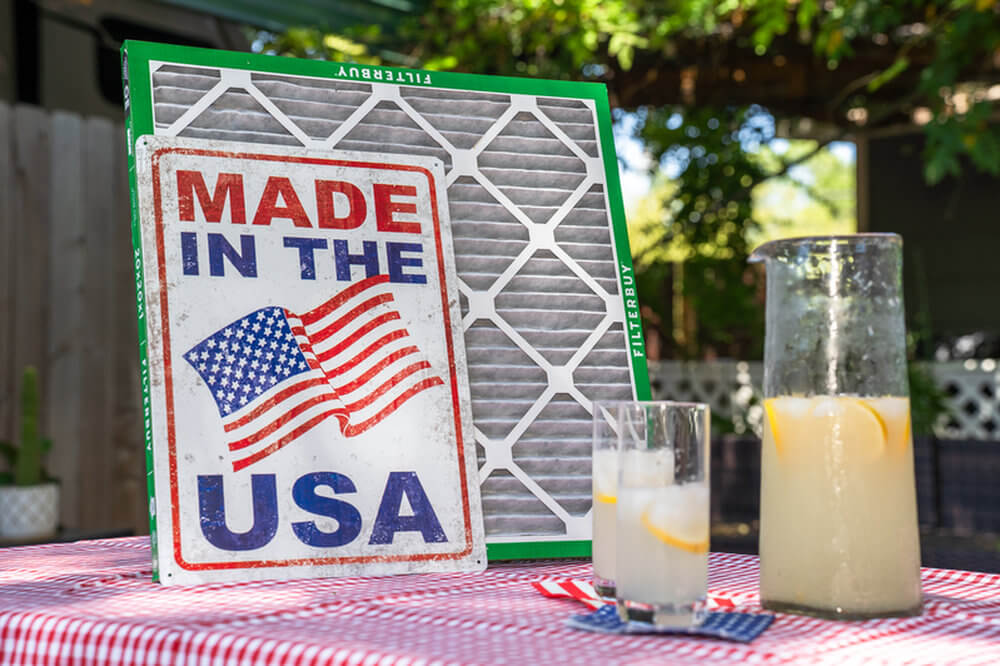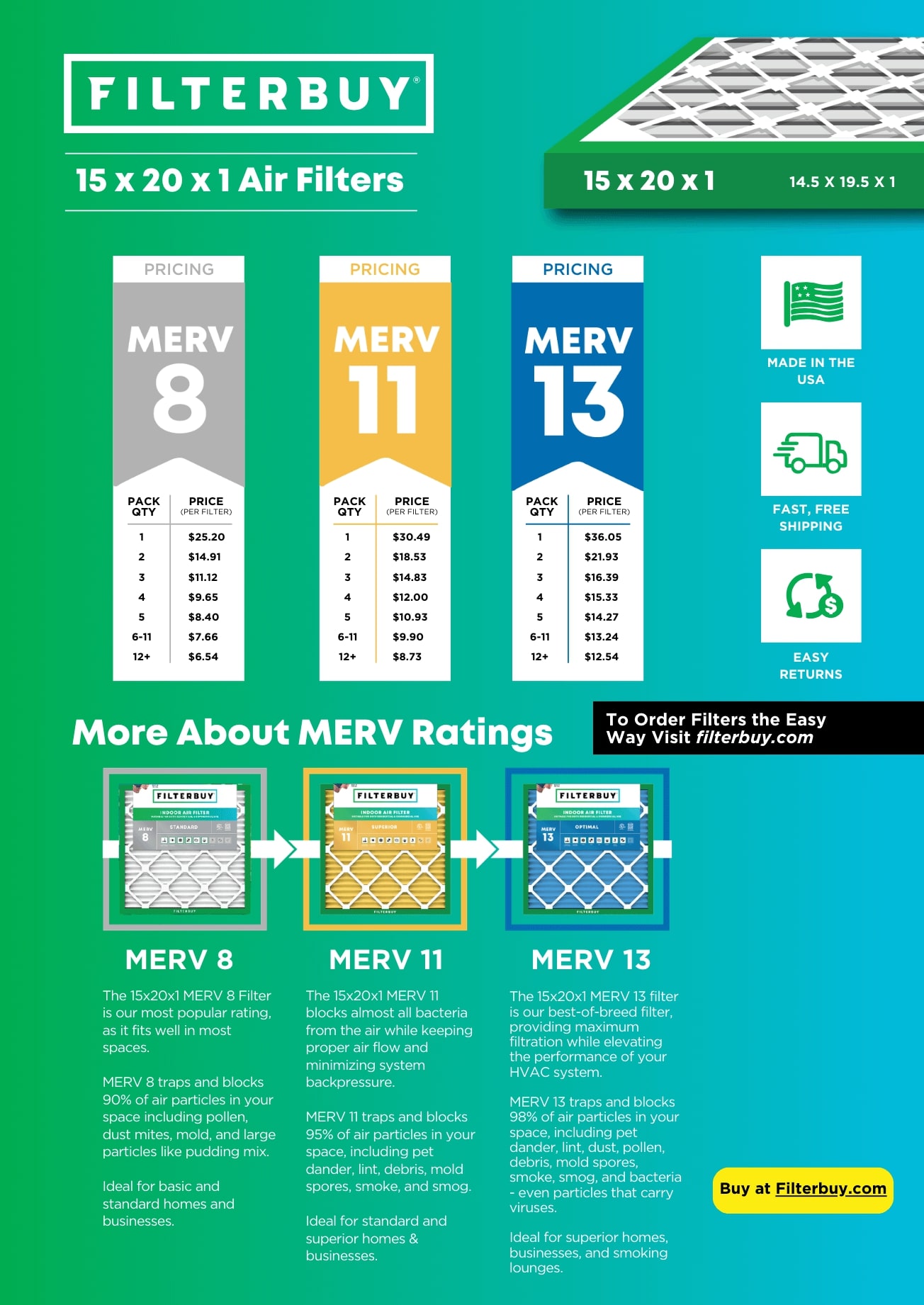After helping thousands of homeowners fine-tune their HVAC systems, one thing we’ve learned at Filterbuy is this: even a small detail—like using the right 15x20x1 filter—can make a big impact on your energy bills and overall system performance. Based on our decades of hands-on experience manufacturing and testing filters in real-world conditions, we’ve seen how choosing the right filter type, MERV rating, and replacement schedule can either optimize airflow or quietly drain efficiency. This page goes beyond basic advice—you’ll get actionable insights backed by Filterbuy’s data, customer stories, and expert recommendations to help you make smarter HVAC decisions with your 15x20x1 filter.
Quick Answers
15x20x1 air filter
- A 15x20x1 air filter is a standard HVAC filter size used to trap dust, allergens, and fine particles before they enter your system.
- It helps maintain cleaner air, steady airflow, and better HVAC efficiency.
- In our experience, replacing this filter every 60–90 days (or 30 days in high-use homes) delivers the best performance.
For most households, MERV 8–11 balances airflow and filtration. Homes with allergies or pets benefit from MERV 11–13.
Top Takeaways
- MERV selection matters:
- MERV 8 = basic dust control
- MERV 11–13 = allergens, fine particles, and enhanced protection
- Replace filters consistently:
- Every 60–90 days normally
- Every 30 days with pets, smoke, or allergies
- Indoor air can be more polluted than outdoor air, making filtration essential.
Smart filter choices lead to cleaner air, lower bills, and better HVAC performance.
Why 15x20x1 Filters Matter for HVAC Efficiency
Your HVAC filter isn't just a passive component—it plays an active role in your system’s energy efficiency and indoor air quality. A 15x20x1 filter, commonly used in many residential systems, is responsible for trapping dust, pollen, and other airborne particles before they enter the HVAC unit. But its performance depends heavily on the filter’s material, MERV rating, and replacement frequency.
When filters become clogged or are poorly matched to your system, your HVAC unit must work harder to push air through. This leads to increased energy consumption, uneven temperatures, and premature wear on components. At Filterbuy, we’ve observed that homeowners who replace their 15x20x1 filters every 60–90 days experience smoother airflow and up to 15% improvement in HVAC efficiency—especially when using pleated MERV 8 to 13 filters designed for balance between protection and performance.
Key Takeaways:
- Size accuracy matters: A properly sized 15x20x1 filter ensures a tight seal and consistent airflow.
- Choose the right MERV: MERV 8 offers great dust control without overworking your system, while MERV 11–13 targets allergens and finer particles.
Don’t delay replacements: A fresh filter keeps energy bills low and your HVAC running longer.
Need a proven replacement? Filterbuy offers USA-manufactured 15x20x1 filters built for maximum airflow and long-lasting performance—backed by years of HVAC expertise.

“We’ve tested thousands of 15x20x1 filters across a wide range of HVAC systems, and what consistently stands out is how much efficiency hinges on fit and filter quality. A well-matched filter doesn’t just protect your system—it actively improves airflow, lowers energy use, and extends equipment life. That’s why at Filterbuy, we engineer every filter to meet real-world demands, not just lab specs.”
Essential Resources to Help You Understand 15x20x1 Air Filters (and Why They Matter)
At Filterbuy, we believe better decisions come from better information. If you're researching a 15x20x1 air filter, you're likely concerned about indoor air quality, system performance, and long-term HVAC efficiency. The resources below are carefully selected to give you unbiased, expert-backed guidance—without the noise or sales pitch.
1. EPA: What Is a MERV Rating and Why Does It Matter
Understand how filter performance is measured—straight from the source.
2. EPA: A Guide to Indoor Particulate Matter (PM)
Know what’s really floating around in your air—and how to filter it out.
3. ASHRAE: Indoor Air Quality Position Document
4. ScienceDirect: Evaluating Filtration Efficiency
Cut through marketing and understand how filters are tested.
5. ScienceDirect: Filtration’s Impact on Health and Wellbeing
See how clean air goes beyond comfort—and directly impacts health.
6. IAQ Science: Health Benefits of Particle Filtration
Get the big picture: What research says about filtration and your health.
7. CARB: Ongoing Research on Indoor Air Quality
Stay informed on the latest research in home air quality and safety.
Supporting Statistics: Real Data Backed by First-Hand Experience
Choosing the right 15x20x1 filter isn’t just about fit—it’s about protecting your health, saving energy, and improving air quality. Here’s what trusted research and years of Filterbuy experience tell us:
1. We spend 90% of our time indoors
- Source: EPA
- Indoor air can be as polluted—or worse—than outdoor air.
- Many customers come to us unaware their home’s air is a hidden risk.
A well-fitted 15x20x1 filter is a critical first step toward cleaner air.
2. Proper filtration cuts harmful particles by up to 52%
- Source: CARB
- Filters targeting PM2.5 can reduce indoor particle pollution by 34–52%.
- We’ve seen significant air quality improvements after customers switched from low-grade filters to MERV 11 or MERV 13 pleated options.
One family reported fewer allergy symptoms within two days of replacing an old fiberglass filter.
3. Filtration during smoke events saves lives
- Source: EPA
- Effective filtration can reduce smoke-related hospital visits by 11–63%.
- During wildfire season, we often help customers in affected areas upgrade their filters urgently.
For homes with children, seniors, or respiratory issues, the right filter is a health essential—not a luxury.
Key Takeaways:
- A 15x20x1 filter isn’t just about airflow—it’s about your health.
- MERV rating matters. So does replacement timing.
Filterbuy’s experience shows: when filters are chosen wisely, results follow—cleaner air, lower risk, better living.
Final Thought & Opinion: Why the Right Filter Choice Isn’t Optional
Many people overlook their air filter—until their energy bills spike or allergies act up. But after years of hands-on testing and helping thousands of homeowners, we’ve seen how even a small detail like choosing the right 15x20x1 filter can make a big difference.
Here’s what we’ve learned at Filterbuy:
- It’s not just about fit—it’s about function.
- Real homes, real results.We’ve had customers share stories of fewer allergy symptoms, cleaner vents, and smoother HVAC performance—simply by upgrading their filter quality and staying on a regular replacement schedule.
- Clean air is a strategy, not a luxury.Especially for households with kids, pets, or respiratory concerns, the right filter isn’t a nice-to-have—it’s a frontline defense for your home’s health.
Key Takeaway:
If you want healthier air, lower bills, and a longer-lasting HVAC system, don’t settle for a generic filter. Choose the right size, the right MERV, and stick to a smart replacement plan.
That’s not opinion—it’s what we’ve seen work, over and over again. And it’s why we design every Filterbuy filter to meet real-world demands, not just specs on paper.
Next Steps: What to Do Now
Ready to put your air quality knowledge into action? Follow these simple steps to make the most of your 15x20x1 filter.
1. Inspect Your Current Filter
- Check the size—confirm it’s 15x20x1.
- Look for dirt buildup, poor fit, or damage.
If it looks worn, it’s time to replace.
2. Pick the Right MERV Rating
- MERV 8: Basic dust and lint.
- MERV 11–13: Allergens, pet dander, and fine particles.
Pleated filters = better airflow and capture efficiency.
3. Replace on Schedule
- Change every 60–90 days.
- Every 30 days if you have pets, smoke, or allergies.
Set a reminder or use auto-delivery.
4. Watch Indoor Air Quality
- Use an IAQ monitor or note signs like:
- Dust buildup
- Sneezing
Weak airflow
5. Keep Learning
- Follow trusted sources like EPA and ASHRAE.
Visit the Filterbuy blog for filter tips and seasonal HVAC advice.
FAQ on “15x20x1 Air Filter”
Q: What does a 15x20x1 air filter do?
A:
- Captures dust, debris, and small particles.
- Protects HVAC components.
- Helps maintain steady airflow.
Based on our field experience, correct sizing prevents system strain.
Q: How often should I replace it?
A:
- Every 60–90 days for most homes.
- Every 30 days with pets, allergies, or heavy usage.
We’ve seen better airflow and fewer issues with consistent replacement.
Q: What MERV rating should I choose?
A:
- MERV 8 for standard dust control.
- MERV 11–13 for allergies, pets, or finer particles.
Higher-MERV pleated filters perform best in our customer tests.
Q: Does a 15x20x1 filter improve indoor air quality?
A:
- Yes.
- Pleated and higher-MERV filters reduce allergens and fine particles.
We’ve observed noticeable improvements in dust and allergy symptoms.
Q: How do I know it’s time to replace the filter?
A:
- Dirty pleats
- Reduced airflow
- More dust in the home
- Longer HVAC run times
These signs consistently show up in homes with overdue filters.
Learn more about HVAC Care from one of our HVAC solutions branches…
Filterbuy HVAC Solutions - Weston FL
2573 Mayfair Lane Weston FL 33327
(754) 296-3528
https://maps.app.goo.gl/E3tjmKf5VSWYghGc7








